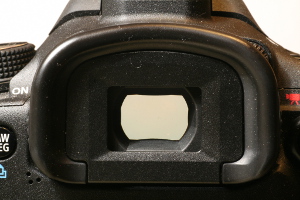
Viewfinder of a digital SLR camera (click to enlarge).
In 2003 I decided to buy my first SLR (single lens reflex) camera. It was a Canon EOS-300, a simple, film based amateur camera. Before, I was often complaining that the pictures I made with compact cameras were not exactly (and often considerably off) what I framed in the viewfinder. Of course, compact cameras (at least old film models) have a different lens for the viewfinder which is not in the same exact position of the photo lens and they don't see the same thing. Having a camera with a single lens used for the viewfinder and for taking pictures is a much better configuration and I was impressed by the results.
But still this wast't perfect: sometimes the frame was still a bit off and I involuntary included parts of unwanted objects in may pictures such as road signs, my car and even my feet. I than decided to investigated a little further and discovered that viewfinder coverage is something that SLR camera manufacturer specify for their products.
The Canon EOS-300 viewfinder has a specified coverage of 90%. What does that mean? How big is the area outside the frame in the viewfinder that is included in the picture? To find out, I decided to do some tests.
There is also another question: 90% of what? Is it a ratio of one side you see in the viewfinder compered of the same side as imaged on the film (or digitized), or is it the ratio of the surface you see in the viewfinder and the surface of the film (or imager)? I wasn't able to find the correct definition. I personally think that comparing the surfaces is a more logical (and useful) approach, but figures are lower... According to the results I got from these tests, it looks like manufacturers take the ratio of the sides.
I installed the camera on a tripod and placed it in front and perpendicular of a wall. I than taped four pieces of cardboard on the wall and adjusted their position to be in the four corners of the frame as I could see through the viewfinder. This is a tricky operation and I had to walk many times between the camera and the wall. To avoid walking too much, I placed the camera at 1 m from the wall, but this length is not relevant for the results. I choose a standard focal length of 50 mm (or 35 mm for APS-C format), but again, this is not relevant for the results.
Once the four pieces of cardboard were perfectly placed and their edges were lining up with what I could see in the viewfinder I took a picture and observed the result. All the pictures are larger than what was visible in the viewfinder: it's a good news, since no part of the intended image is missing and it's always possible to crop the image to obtain the desired result.

Viewfinder of a digital SLR camera (click to enlarge).
Here are reported the results of the tests I made on three different SLR cameras: a Canon EOS-300, an EOS-350D and an EOS-7D. The first is a film camera and two last are digital cameras.
Here, I exposed Ilford FP4 ISO-125 black & white negative film for 1/90 at f/4 with a 50 mm. The developed negative is visible in the picture below.
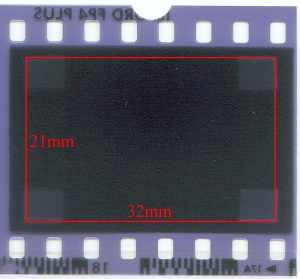
Canon EOS-300 viewfinder coverage on 35 mm negative film (click to enlarge).
The size of the picture is, of course 24 × 36 mm2, typical of 35 mm films. The frame seen through the viewfinder is only 21 × 22 mm2. Comparing the lengths of the sides, we get a coverage of 88%, closed to the specified 90% of the manufacturer (in terms of surface, what you see through the viewfinder is only 78% of the total film surface).
When you print the negative on a 9 × 13 cm2 (3.5" × 5") picture, some of the border is cropped and the coverage gets a little higher, but since you don't control how the image is cropped (and it's not centered!), higher doesn't mean better.
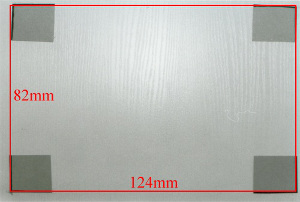
Canon EOS-300 viewfinder coverage on 9 × 13 cm2 print (click to enlarge).
Here the situation is slightly better since the viewfinder coverage represents 82 × 124 mm2 while the print itself is 90 × 130 mm2, meaning that the coverage, in terms of length, is 93% (and 87% in term of surface).
Especially when working with films and prints, it's important to include some margin, because the precision of alignment of the print is far from perfect. A viewfinder coverage slightly less than 100% is not always bad... The print was done by a general public printing company, I would expect a better job from a professional photo laboratory.
The EOS-350D is an amateur digital camera with a slightly better specification than the old EOS-300 and is supposed to have a coverage of 95%. The same test was repeated, this time using a 35 mm lens, exposing for 4 s at f/16 and ISO-100.
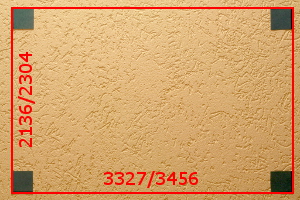
Canon EOS-350D viewfinder coverage (click to enlarge).
Here, what we see in the viewfinder represents 3'237 × 2'136 pixels of the total 3'456 × 2'304 pixels of the captured image. The viewfinder coverage is 93% in terms of length.
In terms of surface, only 6.91 Mpx (megapixel) are visible out of 7.96 Mpx (about 1 Mpx is not visible) and we have only 87%.
The EOS-7D is a completely different beast: it's a semi-professional digital camera and has a considerably better viewfinder. It has a higher magnification, is a lot more bright and is specified 100% coverage.
So, here again, the same test was repeated using a 35 mm lens and exposing for 3.2 s at f/11 and ISO-100.
But with this viewfinder, thing gets more complicated. Because it's larger and has a wider view, you have a little margin to move your eye: if you position your eye to be straight in the middle of the viewfinder and look at the four corners you see a field of view like the one shown below (left image). But if you move a little bit your head, you can actually see slightly beyond the previous frame and you get a larger field of view (right image).
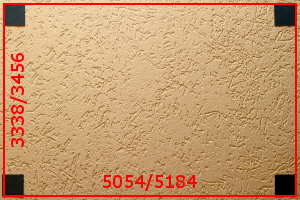
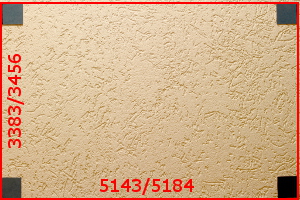
Canon EOS-7D viewfinder coverage.
On the left image the view you get when your eye centered in the middle of
the viewfinder.
On the right image the view you get when moving your eye a little bit to
cover the full field.
(click to enlarge)
The imager has a resolution of 5'184 × 3'456 pixels while the images in the viewfinder are 5'054 × 3'338 pixels (eye fixed) and 5'143 × 3'383 pixels (moving the eye). We can therefore calculate that the viewfinder coverage in terms of sides ratio is 97% and 99% respectively.
In terms of surface, the imager has a resolution of 17.9 Mpx. Out of all these pixels, 16.9 Mpx (94.2%) are visible with the eye fixed and 17.4 Mpx (97%) when moving the eye.
Considering the measurements errors (it's not easy to place the four pieces of cardboard exactly, the wall can be slightly off perpendicularity, the lens has aberrations,...), Canon did a good job with this camera and it deserves the 100% coverage specification, even if the image is still slightly larger than what you see in the viewfinder.
The viewfinder coverage of three different SLR cameras has been tested and measured. Having a 100% coverage is not absolutely important, what is good to know is what kind of coverage you get with the viewfinder you have, so that you can avoid bad surprises.
Having a little margin outside what you see in the viewfinder is a good thing. Ideally, the coverage should be as close as possible to 100%, but never exceed it. And it also should be well centered. Exceeding 100% means that part of what you see while taking a picture is never recorded and should be avoided.
It seems that the percentage of coverage is the ratio of the sides and not of the surface. Numerically the results look different (length ratios are higher than surface ratios), but actually measure the same thing.
Coverage is not the most significant parameter of a viewfinder: magnification, brightness and eye relief are, in my opinion, more important when choosing a camera.
Remark: the choice of the models and the brand of this test is just because I had them available.
| Home | Optics | Page hits: 025183 | Created: 09.2004 | Last update: 12.2013 |